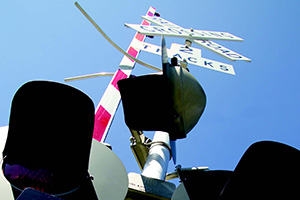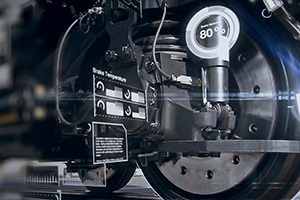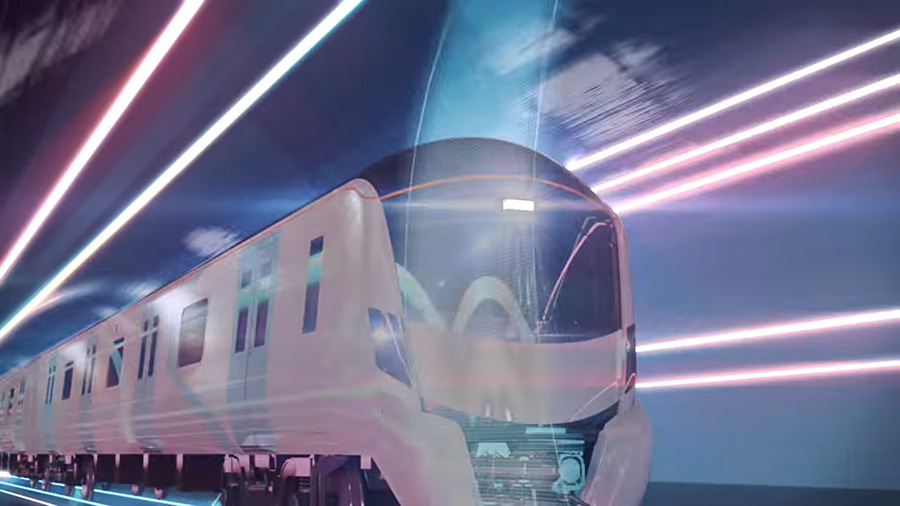By Andrew Martell, Head of Tools and Simulation for U.S. Signaling Product Development, Hitachi Rail
The rail network in the United States is a wonder to behold. And it is impossible not to be in awe of the nation’s freight railroad operators and its public transit providers for maintaining safe, reliable and vital service throughout the pandemic.
For over 150 years, the nation’s rail transportation system has driven our global competitiveness and quality of life. Today, this backbone — freight, passenger and metro rail — within our U.S. infrastructure carries almost one-third of all U.S. exports, delivers millions of tons of goods, and safely transports millions of passengers.1 I’m going to let you in on a little secret: behind the powerhouse of rail, we also have a highly sustainable source of transportation, representing critical infrastructure whether it’s goods moved or people traveling. Rail has a lower carbon footprint with fewer greenhouse gas emissions than other modes of transportation.2
At the heart of any rail network are the employees of the transit authorities and freight railroads whose job it is to maintain the systems, fleets and networks that are vital to safety and mobility. These employees — or maintainers — perform everyday maintenance and repair, run the systems that schedule maintenance, and even manage the flow of rail resources while repairs are being made. This year, we can only imagine how the addition of health and safety measures to prevent the spread of a virus has added to the complexity of systems maintenance and peak optimization.
Maintainers are the unsung heroes of the rail network — they’re seldom seen, yet they’re vital to the smooth running of operations. Their work helps to ensure that trains run on time, passengers get where they are going, and freight gets to its destination without delay.

A wigwag is a railroad grade crossing signal that warns of an approaching train.
Like the wigwag, the maintainer stands between a rail system and threats to its physical safety and efficiency. The maintainer’s job is to perform essential maintenance, keeping the infrastructure in its best operational shape. Think “peak performance.” And, it will come as no surprise that maintainers are essential to addressing and resolving railroad maintenance issues, system-based problems, troubleshooting for both planned and unplanned events that could impact tons of freight, rail safety of millions of passengers, and the good life we enjoy as consumers.
The maintainer’s job also demands a high level of domain-specific expertise. It’s common to see maintainers who have 25+ years of experience on the job, with expertise in a specific rail or metro network. For example, a maintainer that works in the Philadelphia area is a ‘Philly’ expert. That person has a particular set of skills and knowledge on that network, and is likely to have an in-depth understanding of nearly every element of that system.
By 2050, the world’s population living in cities is expected to increase from 55% to 68%, representing 2.5 billion more urban residents, according to the United Nations.3 With freight and passenger volumes expected to continue to increase but track and other resources remaining more fixed, you can see that maintainers are being called upon to extend the overall capacity of the rail system with the goal of moving more people and freight.
Since 1980, the density of rail traffic has increased by 200% and the average volume of freight carried per train has increased 63%.4 This increased capacity puts an even greater spotlight on the maintainers and the systems they use. Some rail systems are 50 years old or more, and all are complex.
New technology is needed, and maintainers — experts in the existing technology — are being called on to work with new tools.

Although rail systems have advanced technologically over the past 20 years, other industries have adopted digitalization at a faster rate. Vital safety requirements at the core of the rail industry makes a measured approach to adoption somewhat comprehensible.
However, as today’s domain experts approach retirement age, consider the importance of knowledge transfer to the next generation of workers, many of whom may have grown up with digital technologies and tools. As electromechanical engineers design with and for digital technology, some older tools run the risk of becoming obsolete. The industry has reached a tipping point where digital transformation is vital, dynamic and essential.
This mixing of old technology with new, as well as the shift to a more tech-driven workforce, means that the rail industry is experiencing the upheaval of the perfect storm. And this was before Covid-19. We can also think about part of this disruption as caused by the sheer variety and volume of tools from product-centric vendor solutions. Although these tools may solve for a specific issue, they don’t necessarily work together or integrate with other systems. So, product-centric solutions adds yet another layer of complexity to the work of the maintainer.
Rail systems are already complex environments for maintenance and emergency response. Requiring maintainers to learn multiple new products on the fly can lead to disruption, especially if the standalone solutions don’t ‘share’ information.
The answer to navigating this storm is to use an integrated technology platform that combines information from communication subsystems, central offices, waysides, and other solutions into one system. This seamless, vendor-agnostic approach allows the maintainer to learn one system to perform essential tasks across the authority and across operations.

A platform-centric approach gives maintainers immediate access to information across the rail system. It helps them take immediate action during an unplanned outage — for example, if a train is stuck in a tunnel with passengers on board. In this situation, the digital platform provides in-depth diagnostics. The platform can pinpoint where the issues are and what to do, so that maintainers can quickly resolve the issue, put the system back online, and get the train moving again.
This digital approach is holistic in nature, bringing a new level of accountability to the system. And, data is archived so that it can be audited, and past actions and problems can be researched and reviewed by both maintainers and transit authorities.
In one real-world example, one transit authority in North America needed a way to collect information from the systems across its network for actual events as they occurred. With distributed systems in different locations, the authority wanted to standardize how it collected and archived its’ data. Then it needed to aggregate the data, ensure its consistency, and apply some level of automation to this process. To make this happen, Hitachi Rail is helping to deliver a platform that aggregates and normalizes network-wide data for instant use. By listening to maintainers, this transit authority can now access data from anywhere in the network using an intuitive user interface. The digital platform solution helps the authority run operations smoothly and respond quickly to unplanned events.

With the proliferation of product-centric solutions on the market today, it can be challenging for decision-makers to choose the systems that best support their maintainers in doing their jobs. When looking for a solution-oriented vendor, here are some things to think about.
Identify the most critical challenges your organization faces and look for what they have in common. Is your best choice a single product, even though you’ll have to manage it independently? Or do you need a platform so you can manage all your systems from one interface to simplify the work of your maintainers?
Avoid choosing new players in the market, offering quick fixes for big issues. Look for leaders with proven industry domain expertise — you’ll see that this type of relationship will support you over the long-term. If you’ve chosen a platform approach, you’ll want a vendor that can help you get the most from your existing and future investments and provide you with examples of their successes with other transit authorities.
Finally, consider the bedrock value of trust. Look for references that are customer-focused and demonstrate integrity as a trusted partner. With a vendor that takes a customer-centric rather than a product-centric approach, you will have a team that can help you integrate your systems. You’ll also gain a platform that will make it possible to evolve your decision-making as you move forward.
There’s a lot at stake for today’s maintainer, as transit authorities increase capacity and gain more from their architecture.
Railway engineering organizations need breakthrough solutions that let their maintainers access, analyze, interpret and optimize data across their systems for ensuring rail safety, smooth running of trains and the peak performance of the rail network.
With the EasyRail™ platform from Hitachi, maintainers can access integrated, vendor-agnostic data across multiple systems, seamlessly delivered on one platform to support decision-making across the authority. And EasyRail™ can be deployed on equipment from other suppliers, delivering a unified view across all systems.
Our goal at Hitachi is to contribute to society by creating superior technologies that support our vision for powering good. Our EasyRail™ platform is an innovation for customers who are looking at mobility as a service (MaaS) to help ensure innovation along with the continued mobility of people and freight as volumes grow. Hitachi’s platform delivers the digital technologies that will help transit authorities and freight operators — and maintainers that operate their very complex infrastructure systems — to move forward confidently with digital transformation.
To learn more about how a platform approach would work for you, talk to us http://www.hitachirail.com/.

By Andrew Martell, Head of Tools and Simulation for U.S. Signaling Product Development, Hitachi Rail
Andrew Martell is graduate of Harvard University and Head of Tools and Simulation for US Product Development within Hitachi Rail. His innovative drive and determination to help customers succeed has led to several patents. Hitachi Rail as a totally integrated, global railway solutions provider with rolling stock, signalling and systems’ integration, operations and maintenance, and digital solutions.